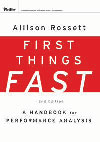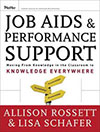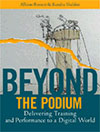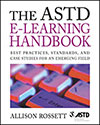Compliance training satisfies few who experience it. Not only do we often fritter away this opportunity, I have come to believe that compliance training promotes cynicism about all of workplace learning.
Complaining about compliance is not good enough. I convened a panel devoted to improving compliance training at the Corporate Learning Summit conference in Chicago.
Meet the panel
I sought panelists who believe in enhanced compliance and regulatory training. Meet three optimistic and active learning executives. Samantha Hammock is Vice President, Regulatory Learning and Administration, for American Express. Justin Lombardo was recently Vice President and Chief Learning Officer at Children’s Medical Center, Dallas, and served for nine years as Chief Learning Executive at Northwestern Memorial Hospital in Chicago. Sandy Quesada is at Amtrak as their Senior Organizational Development and Learning Leader. Sandy has led learning organizations at BP, Eli Lilly, Wachovia and Ryder Trucking.
Sam, Justin and Sandy delivered practical and actionable messages about advances in the increasingly prevalent and often unpopular world of compliance and regulatory training.
It is time for change
While the panel acknowledged that the task is daunting, they were buoyant. In their view, most compliance efforts set a low bar. Amtrak’s Sandy Quesada urged workplace learning professionals to “make it [compliance and regulatory training] meaningful, to worry about how to sustain it” beyond training events. Quesada described how Amtrak puts a human face on security and safety goals in order to help employees embrace individual responsibility for their actions.
Justin Lombardo discussed efforts to go beyond compliance behaviors to highlight patient outcomes. Medical professionals, he noted, respond to patient and family experiences more than ticking off regulatory expectations.
With employees in 32 countries, 23 business units, and six different regulators who “don’t necessarily see things the same way,” Samantha Hammock pushed back at “zero knowledge transfer,” and instead identified opportunities for improvement through data, reporting and transparency.
Personalization is better than sheep dipping
 Sam Hammock mentioned two syndromes that injure compliance efforts: Most harmful is “everybody takes everything.” American Express set about personalizing compliance programming through a systematic process to settle on foundational regulatory material as distinct from that which is unique to roles and geographies. What is it that everybody must take? What are the more individualized expectations and needs? Once she had hard-fought answers to those questions, she turned to technology, assessments, pathways and branching to deliver both universal and personalized training, information and support.
Sam Hammock mentioned two syndromes that injure compliance efforts: Most harmful is “everybody takes everything.” American Express set about personalizing compliance programming through a systematic process to settle on foundational regulatory material as distinct from that which is unique to roles and geographies. What is it that everybody must take? What are the more individualized expectations and needs? Once she had hard-fought answers to those questions, she turned to technology, assessments, pathways and branching to deliver both universal and personalized training, information and support.
Hammock also lamented the “NEXT, NEXT” syndrome, which is online compliance training characterized by extended mindless pressing of the NEXT button. When all employees are sprayed with the same training, their fingers get engaged with that NEXT button, but their minds, hearts and bellies probably do not. The answer, of course, is programming that speaks to individual needs and selected organizational priorities.
Culture rules compliance
Sandy Quesada said: “Culture devours even outstanding compliance training.”
Emphasizing the power of culture for positive and negative influence, Sandy highlighted consistency, role clarity and alignment in producing sounder experiences for Amtrak passengers and employees. She described the new Amtrak program, Safe-2-Safer. The goal of the program is to develop a pervasive culture, with safety consciousness and activities embedded in everyday activities. Not surprisingly, the program leans heavily on supervisors. It is their systematic observations and interactions that assure “citizens of Amtrak with responsibility for safety across the workplace and for our customers.”
What’s it all about, really?
Justin Lombardo reminded us to consider the purpose for the compliance training. While regulatory departments do sometimes issue fiats and even threats, Lombardo highlighted the meaning in the matter. Acknowledging the tendency to acquiesce in the face of regulatory matters, he exhorted learning professionals to say: “Show me the actual regulation!” He noted that it is beneficial to sit down with compliance officers to examine regulatory documents. What is in the document? What does it say? What does it mean? What is the purpose here? Where is the risk? What is important about these matters and how do these efforts link to the outcomes the organization values? While there is no question that something must be done, the place to start is with ends, not means. Net, net, are we talking about awareness, knowledge or dependable performance and habits? These are important and debatable distinctions, especially when compared with requirements for attendance at an event or time served online.
View the regulations as opportunities for partnership with regulators.
The panel warned against passive acceptance of regulations. American Express’ Hammock offered hope as she noted that she has had some success working as a partner with regulators. Sandy Quesada made the same point, “The regulations can be discussed.”
 Noting that some risk is involved, Justin Lombardo suggested a certain amount of pushing back. He also recommended involving “C” level executives from similar organizations in the process with regulators. He put it this way, “If five COOs from five hospitals file a brief, it’s powerful.” It makes sense to enlist leaders in visible leadership regarding compliance efforts inside and outside the organization.
Noting that some risk is involved, Justin Lombardo suggested a certain amount of pushing back. He also recommended involving “C” level executives from similar organizations in the process with regulators. He put it this way, “If five COOs from five hospitals file a brief, it’s powerful.” It makes sense to enlist leaders in visible leadership regarding compliance efforts inside and outside the organization.
Leverage technology to measure, communicate, document and nudge.
The panelists agreed that technology has much to offer. Hammock wondered if American Express people don’t especially favor the reporting and tracking delivered through dashboards, perhaps even more than online and on demand compliance training modules.
A gentleman in the audience, Professor Colin Coulson-Thomas from the United Kingdom, pointed to success he was experiencing with performance support to remind, nudge and advance compliance activities. Hammock agreed and reported that American Express is using performance support as a component in their programs. No surprise, she is now fielding questions from regulators about how to metric the performance support contribution.
No more knee jerk compliance training!
Many criticize compliance and regulatory training. In the Harvard Business Review in 2012, Peter Bregman wrote apiece titled, “Diversity Training Doesn’t Work.” Bregman cited a study of hundreds of companies over 30+ years that showed limited positive effects in the workplace. What did work? Clear roles. Responsibility advanced through accountability. Mentor programs also influenced performance, as did small internal groups with responsibility for furthering and monitoring key ideas.
As Charles Jennings wrote in a blog post rich with examples, “The list of non-compliance incidents in highly regulated industries could go (on) almost ad infinitum.”
We are talking about ethics, safety, finance, privacy, hazardous waste, bullying, sexual harassment and abuse… this list is long and it grows longer. When you reflect on these topics, it’s obvious that they matter to individuals and to their organizations.
So something must be done– just not the knee jerk stuff.
That’s the essence of what the panel said. It can be done. It should. And it is– in some cases. What about your organization?
+++++++++++++
Allison Rossett consults on learning, technology and results. She is grateful to Sam, Sandy and Justin for their actionable contributions to this gnarly subject.






Thank you for this excellent article (and the mention), Allison.
Compliant behaviour relies on a number of factors but is primarily cultural. Training can sometimes help, but is never the whole answer and organisations that assume compliance training equals compliant behaviour need to think a more deeply.
I think Dan Pink’s 3-part engagement model is a very good starting point for anyone responsible for helping build a culture of compliance in their organisation.
AUTONOMY – people need to feel they have personal responsibility for their behaviour and the ability to make decisions about the ‘right things’ to do.
MASTERY – this is where training can help. People need to feel equipped with enough information to make the right decisions.
PURPOSE – if people don’t feel engaged and aligned with the values of their organisation and particularly of their leaders, they’re less likely to display compliant behaviour.
Charles
One thing missing here is a definition of what compliance training is. I think most people have a generalized idea, but (as you know) “generalization” can mean “understanding varies widely.”
Most organizations have some form of mandatory “training” on topics like EEO and avoiding sexual harassment, but as your panelists say, that needs to relate to the individual’s reality.
Even safety training at Amtrak, where I worked for more than 10 years, has one meaning if you’re in on-board service or maintenance of way, and another if you work in a reservation center. A ticket agent at Chicago Union Station doesn’t run the same risk of injury as a dining-car attendant or someone who maintains rolling stock.
If you don’t acknowledge that in your training, and if you don’t follow through back on the job, then compliance training produces about as much in the way of results as wishing upon a star.
Like most people, I’ve had a lot of mandatory training inflicted on me. If I never have to sit through another EEO course droning on about (for example) what year the Americans with Disability Act was passed, that’ll be a fine thing — because to my way of thinking, the outcome of EEO-related training (or information) is that I can answer to questions like:
– What kinds of behavior are flat-out illegal?
– What kinds of behavior violate our policies?
– What can I do to avoid such behavior on my part?
– What happens when such behavior occurs?
In the “what happens” category, you can include things like the organization’s inability to attract or retain high-quality people.
Allison thanks for discussing this important and often overlooked issue. There are no easy answers in good compliance training but you point out many of the right questions we can ask to improve what we do. I look forward to following this discussion and learning more from the comment stream
Hi Allison,
Thanks ever so much for posting this article at the time you have as it’s very relevant to a piece of work I am doing in my organisation at the moment.
I am working towards the cessation of mandatory elearning courses (as we know it) and replacing them with a series of ongoing, organic, asymmetric campaigns that places the learning into peoples workflows as opposed to taking them *out* of their workflows to undertake it.
I’m writing a series of blog posts on the subject at the moment, here’s the first:
http://tayloringit.com/2013/04/from-compliance-course-to-campaign-part-1-the-background/
Allison – Thanks for this! Wonderful stuff. Indeed compliance training projects ARE the most challenging. I love the alternative ideas you’ve gathered here — both in the original post and the comments. – Russ